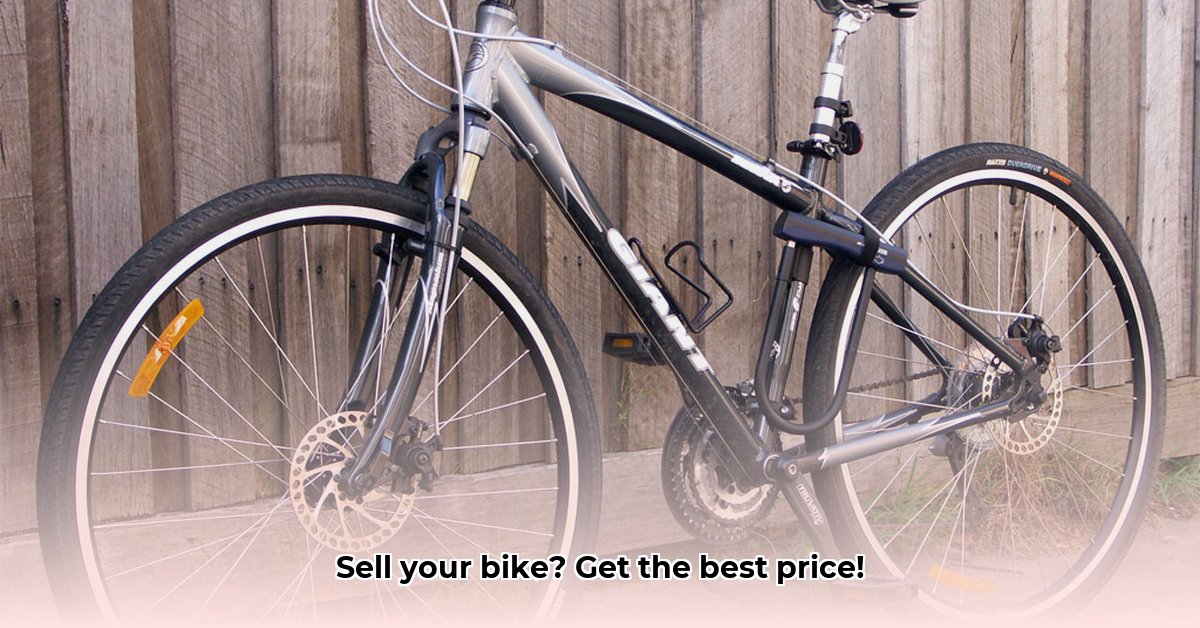Ready to turn your used bike into cash? This guide provides a comprehensive approach to evaluating, pricing, and selling your bicycle effectively, ensuring you get the best possible return. From understanding the factors that influence bike value to crafting a compelling listing and navigating local market nuances, we’ll equip you with the knowledge and strategies needed to navigate the used bike market successfully.
Bike Value: Getting Top Dollar for Your Used Bicycle
Selling your used bike doesn’t have to be a guessing game. Maximize your profit by understanding what buyers are looking for, presenting your bike in its best light, and tailoring your approach to your specific location. Just as a little preparation goes a long way when selling a car, a bit of effort can significantly boost your bike’s resale value.
What Makes Your Bike Worth More? The Key Factors Influencing Bicycle Prices
Several factors determine the value of your used bicycle, from brand recognition to the time of year and even your geographic location. Understanding these elements ensures you focus on the details that matter most to potential buyers.
- Age Matters: Bikes depreciate, with newer models generally fetching higher prices. The value drops significantly the moment a new bike is ridden off the lot, but the rate of depreciation slows over time.
- Brand Recognition: Trusted brands like Trek, Specialized, and Giant often hold their value better due to their reputation for quality, performance, and warranty support.
- Condition is King: A bike in excellent condition with minimal wear and tear commands a premium. Scratches, rust, and worn components can significantly decrease its worth. Regular maintenance records can also add value.
- Market Trends and Demand: The bicycle market fluctuates with seasonal changes (spring and summer are typically peak seasons), specific bike types being in higher demand at different times of the year (e.g., e-bikes), and overall economic conditions (supply chain disruptions can increase used bike values).
- Upgrades: High-end components can increase value, but don’t expect to recoup the full cost. Transparency with receipts regarding upgrades is essential.
- Location, Location, Location: Demand, cycling culture, and even the availability of specific types of terrain can impact the value of bikes in different geographic locations (more on this later).
Selling Your Bike: A Step-by-Step Guide to Success in the Used Bicycle Marketplace
Once you understand what influences your bike’s value, follow these steps to maximize your profit and streamline the selling process.
- Honest Self-Assessment: Realistically evaluate your bike’s condition before listing it. Be honest about any damage or needed repairs.
- Research the Market Value: Start with online resources like Bicycle Blue Book but compare findings with actual sales on platforms like eBay, Craigslist, Facebook Marketplace, or local bike shops. Filter by “sold” listings to see actual sale prices, not just asking prices.
- Clean Up Your Act: A clean bike photographs better and attracts more buyers. Wash the frame, degrease the chain, and inflate the tires.
- Capture High-Quality Photos: Take clear, well-lit photos of the entire bike and close-ups of any notable features (or flaws). Use a neutral background.
- Craft a Compelling Listing: Write a clear and concise description, highlighting key features, condition, notable upgrades, and reasons why someone would want to buy your bike. Include the frame size! Be honest about any issues.
- Price Strategically: Research comparable bikes and price competitively. Pricing slightly below market value can attract quick buyer interest. Consider leaving room for negotiation.
- Choose the Right Platform: Select a platform that aligns with your target audience—local classifieds for local buyers, online marketplaces for a wider reach, and specialized forums for discerning buyers. Consider the platform’s fees and policies.
Advanced Tactics for Maximizing Your Profits in the Bicycle Market
Consider these extra tips to further enhance your sale and achieve the highest possible return.
- Consider Selling Parts Separately: If your bike has high-value components like carbon wheels, a high-end groupset, or a desirable suspension fork, selling them individually may yield more than selling the whole bike. However, this requires more time and effort.
- Flexibility is Key: If you need to sell quickly, being flexible on price can facilitate a faster transaction. Weigh urgency against the potential for a higher price. Be prepared to negotiate.
- Time it Right: Time your sale to coincide with peak season (spring/summer), local events like bike races or cycling festivals, and overall economic conditions for optimal returns.
- Offer Test Rides (Safely): Allowing potential buyers to test ride the bike can increase their confidence and make them more likely to buy. Meet in a safe, public location and ask for identification.
- Be Responsive: Respond promptly to inquiries and be willing to answer questions thoroughly. Good communication builds trust.
Understanding Depreciation: The First Year Dip in Bicycle Value
The initial depreciation is a significant factor in the used bike market. After the initial plunge, the depreciation rate usually slows down to approximately 10% annually. Minimizing financial losses involves buying used to begin with or taking excellent care of the new bicycle.
Brand Matters, but Condition Reigns Supreme in the Used Bicycle Market
Well-known brands benefit from consumer trust and confidence, but a bicycle that is clean with well-maintained components will always sell for more. People know these names and trust their quality and are thus willing to invest. Even a top-tier bike in rough shape will sell for far less than a well-maintained, lesser-known brand.
The Crucial Role of Condition Assessment in Bicycle Valuation
Before you even think about setting a price, a realistic assessment of your bike’s condition is crucial.
- Mint: Essentially new, ridden very few times, with no signs of wear.
- Excellent: Rides like new, very well-maintained, with no noticeable wear.
- Good: Rides well, but with some signs of use on the frame and components (e.g., minor scratches).
- Fair: Rides noticeably poorer, may not have been consistently well-maintained, with potential issues like brake inefficiency or worn components.
- Poor: Significant problems, likely ridden hard with little maintenance, potential frame damage (dents, but no cracks), and major component issues.
How to Accurately Price a Used Bicycle Considering Component Upgrades: A Step-by-Step Guide for Sellers
- Baseline Value: Start with an online valuation tool like Bicycle Blue Book. Input your bike’s make, model, and year to get a preliminary assessment.
- Component Upgrade Evaluation: New wheels, groupsets, or brakes can significantly boost value. Document these with receipts, and research current market prices for these parts. A good rule of thumb is to expect to recoup 25-50% of the original cost of the upgrade, depending on its age and condition.
- Market Research: Search online marketplaces (eBay, Craigslist, Pinkbike, Facebook Marketplace) for similar bikes with comparable features and upgrades. Filter by sold listings.
- Condition Adjustment: Adjust the price based on your honest assessment. A pristine bike commands a premium, while a “well-used” bike will fetch considerably less.
- Final Price Determination: Consider the baseline value, upgrade value, and condition to determine your final asking price, reflecting your bike’s specific features and condition. Factor in your urgency to sell and local market conditions.
The Impact of Component Upgrades on Resale Value in Bicycle Sales
Upgraded components are a double-edged sword.
Pros:
- Increased Value: High-quality upgrades (e.g., carbon fiber wheels, top-tier groupsets, suspension upgrades) will significantly boost your bike’s worth.
- Attracts Buyers: Upgrades are attractive to those seeking high-performance or specific features, widening your potential buyer pool.
Cons:
- High Initial Cost: Upgrades can be expensive, reducing your initial profit margin.
- Specialized Components: Highly niche upgrades might not appeal to many buyers, making it harder to sell.
- Compatibility Issues: Upgrades must fit seamlessly; incompatibility issues can reduce value.
Selling Your Enhanced Bike: A Strategy for Success in the Bicycle Market
High quality photos are essential. Clean your bike meticulously. Choosing appropriate platforms to advertise your bike will help optimize exposure.
Factors Affecting Used Bicycle Prices in Specific Geographic Locations that Influence Sales
Understanding the factors that specifically apply to your region can significantly impact your chances of a successful sale.
How Location Influences Bike Value
- Local Cycling Culture: Areas with strong cycling communities tend to have higher demand for bikes, leading to better resale values.
- Terrain: The type of terrain prevalent in your area influences the demand for different types of bikes. For example, mountain bikes will be more valuable in areas with extensive trail networks, while road bikes may be more popular in flatter regions.
- Competition: The number of similar bikes for sale in your area can impact pricing. A saturated market may require you to lower your price to attract buyers.
- Climate: In areas with long winters, demand for bikes may decrease during the off-season, affecting resale values.
- Economic Conditions: Local economic conditions can also play
- Vertical Axis Wind Turbine Design: Improving Efficiency and Overcoming Limits - October 29, 2025
- Wind Turbine to Power Home: Nacelle Design Improvements Advance - October 26, 2025
- Wind Turbine Blade Length: How Long Is Too Long? - October 24, 2025
















